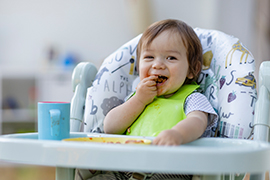Choking Prevention and Awareness
You can download this article as a PDF (English) (Spanish).
Choking happens when a small object, toy or piece of food blocks the airway. Babies and young children have very small airways. This makes it easier for them to choke.
 How can food cause choking?
How can food cause choking?
Babies and young children are not able to chew or grind their food well. Their mouth muscles are not fully developed, and they do not have as many teeth as older kids and adults. Food that is round, hard, difficult to chew or slippery can slide into their throats, block the airway and cause choking. These are some foods that can cause choking:
- Hot dogs and sausages
- Grapes, cherries and cherry tomatoes
- Hard fruit with peels, like apples and pears
- Whole fruit with pits, like plums, nectarines and apricots
- Lychee, kumquats, berries, mango and melon balls
- Raw carrots, celery and other firm, tough or stringy raw vegetables
- Chunks of nut butter
- Candy and gum
- Popcorn
- Nuts and seeds
- Chips (potato, corn, tortilla) and pretzels
- Chunks of meat or cheese
- Marshmallows
What can I do to help prevent my child from choking on food?
- Do not feed children younger than 4 years or age any round, firm food unless it is cut into small pieces. Pieces should be no larger than one-half inch. Cut whole grapes into quarters. Slice hot dogs and sausages lengthwise into 4 long strips and then into small bits.
- Cut all other food into bite-size pieces.
- Remove pits and seeds.
- Cook, mash or grate hard foods.
- Steam vegetables until they are soft.
- Cook food such as beans, pasta and rice until soft.
- Serve babies small amounts of food at a time. Make sure their mouth is clear before giving another bite of food.
- If your baby is teething, use a teething ring, not food. Even a baby with no teeth can break off chunks of food and choke.
- Have your child sit in a high chair or at the table when eating.
- Always watch your child when they eat. Teach them to eat slowly and take time to chew.
- Do not feed your child when they are laughing or crying.
- Turn off screens, like the TV, tablet and smartphone during meal and snack times. Choking can happen when a child is distracted by something else.
- Avoid letting your child eat in the car. If your child starts to choke, it can be hard to safely pull over fast enough.
How can we avoid other choking risks?
- Keep small items away from babies and young children. If an item can fit inside of a toilet paper tube, it is too small. Some examples of items that are too small for babies and young children to have are coins, marbles, magnets, buttons, tiny hair clips and pen or marker caps.
- Check toys and games for small parts that could be pulled off. Remove loose parts, such as eyes and buttons from dolls, wheels from cars and loose screws.
- Know which devices in your home use button and coin batteries and keep those items out of reach or ensure the battery compartment is secured. These batteries are found in games and toys, remote controls and many more common items. In addition to being a choking hazard, they can be very harmful to your child. If you think that a child has ingested a battery, call the 24-hour National Battery Ingestion Hotline at 800-498-8666 right away or take them to an emergency room immediately.
- Throw away broken toys, games and crayons.
- Keep your purse, sewing basket and toolkit out of the reach of young children.
- Choose Mylar (foil-type) balloons. Latex balloons are a choking risk to children of all ages because latex material can stretch and mold to a child’s throat, blocking the airway.
How can I be prepared in case of a choking emergency?
There are things you can do to be more prepared for a choking emergency. You and your child’s other caregivers can learn first aid, CPR, infant choking rescue and the Heimlich maneuver for children 1 year of age and older. Post first aid instructions for choking in your home. Also post the number “911” and your name, address and phone number by each phone in your home or in a visible spot, like on the refrigerator or family bulletin board.
Call 911 if your child:
- Is choking or struggling to breathe
- Can’t cough, cry or make any noise
- Has blue lips or skin, has passed out or is limp
If you or someone else treated your child with the Heimlich maneuver, take your child to see a healthcare provider right away. It is important to check for any items your child might have breathed into their lungs.
